Method 1 The government sets pollution standards Method 2 Th
Method 1: The government sets pollution standards. Method 2: The government allocates tradable pollution permits. Compare the two methods to determine the least-cost way of achieving the desired pollution quantity. Eliminating pollution can be more difficult (and thus more costly) for some kinds of firms than for others. The following table shows the cost of eliminating each unit of pollution for each of the three firms. Cost of eliminating the first unit of pollution Cost of eliminating the second unit of pollution Cost of eliminating the third unit of pollution Cost of eliminating the fourth unit of pollution Firm X $90 $125 $180 $1,260 Firm Y $55 $70 $110 $550 Firm Z $650 $800 $1,500 $9,000 Under method 1, the government sets pollution standards so that each firm must reduce its pollution by 2 units. Fill in the following table with the total cost to each firm of reducing its pollution by this amount. Firm X Firm Y Total cost of eliminating 2 units of pollution Adding up the costs to the three firms, you can see that the total cost of eliminating 6 units of pollution through regulatory standards is Now suppose the government uses method 2 to reduce pollution in the area from 12 units to 6 units by issuing two pollution permits to each firm. For each permit a firm has in its possession, it can emit 1 unit of pollution, but firms are also free to trade pollution permits with one another. For example, if firm Z were to buy a permit from firm Y, firm Z would end up with three permits and would need to reduce its pollution by only 1 unit, whereas firm Y would end up with only one permit and would have to reduce its pollution by 3 units. Assume the negotiation and exchange of permits are costless. Because of its high pollution-reduction costs, firm Z might be better off buying permits from firm Y and firm X so that it doesn\'t have to reduce its own pollution emissions. At which of the following prices are both firm Y and firm X willing to sell one of their permits to firm Z? Check all that apply $160 ? $415 $50 $390 Again, suppose that you are considering the method of pollution reduction involving tradable permits. Suppose the owners of the three firms get together and agree on a trading price of $170 per permit. Fill in the following table with the action taken by each firm, the amount each firm will pollute, and the amount it costs each firm to reduce pollution to the necessary level. (Hint: Do not include the prices of permits in the cost of reducing pollution.) Firm X Firm Y Firm Z Initial pollution permit allocation Action Final pollution amount Cost of pollution reduction 2 units 2 units 2 units Given this scenario, the total cost of eliminating 6 units of pollution using a tradable permit system is On the basis of this example, you can conclude that eliminating pollution is allocates pollution permits that can be bought and sold than when it directs each firm to eliminate a certain amount of pollution. costly to society when the government


Solution
Ans:
1) Total cost of eliminating two units of pollution
Firm X = $90 + $125
= $215
Firm Y = $55 + $70
= $125
Firm Z = $650 + $800
= $1450
Total cost of eliminating 6 units of pollution through regulatory standards = $215 + $125 + $1450
= $1790
2) $415, $390
The cost of eliminating third unit of pollution to firm X is $180 and firm Y is $110.Hence at a price which is above $180 both firm X and firm Y will sell a permit to firm Z.
3) when the permit price is $170, only firm Y will sell a permit to firm Z.
Total cost of eliminating 6 units of pollution using a tradable permit system = $215 + $235 + $650
= $1100
4) Less
Eliminating pollution using tradable permits is less costly to society.
| Particulars | Firm X | Firm Y | Firm Z |
| Initial pollution permit allocation | 2 units | 2 units | 2 units |
| Action | Don\'t buy/sell | sell one permit | buy one permit |
| Final pollution Amount | 2 units | 3 units | 1 unit |
| Cost of pollution reduction | $90 + $125 = $215 | $55 + $70 +$110 = $235 | $650 |


 Homework Sourse
Homework Sourse